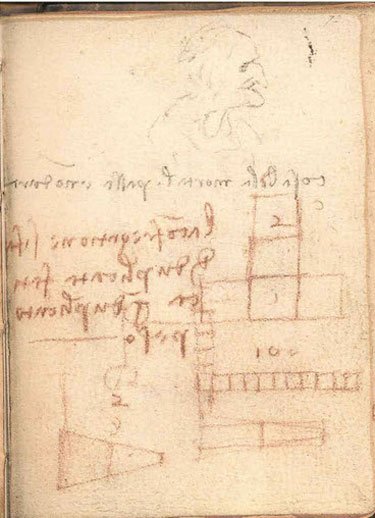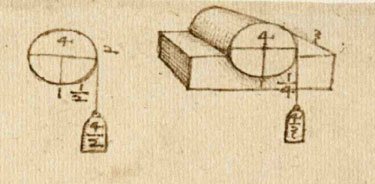University of Cambridge Research:
Scribbled notes and sketches on a page in a notebook by Leonardo da Vinci, previously dismissed as irrelevant by an art historian, have been identified as the place where he first recorded his understanding of the laws of friction.
The research by Professor Ian Hutchings, Professor of Manufacturing Engineering at the University of Cambridge and a Fellow of St John’s College, is the first detailed chronological study of Leonardo’s work on friction, and has also shown how he continued to apply his knowledge of the subject to wider work on machines over the next two decades.
It is widely known that Leonardo conducted the first systematic study of friction, which underpins the modern science of “tribologyâ€, but exactly when and how he developed these ideas has been uncertain until now.
Professor Hutchings has discovered that Leonardo’s first statement of the laws of friction is in a tiny notebook measuring just 92 mm x 63 mm. The book, which dates from 1493 and is now held in the Victoria and Albert Museum in London, contains a statement scribbled quickly in Leonardo’s characteristic “mirror writing†from right to left.
Ironically the page had already attracted interest because it also carries a sketch of an old woman in black pencil with a line below reading “cosa bella mortal passa e non duraâ€, which can be translated as “mortal beauty passes and does not lastâ€. Amid debate surrounding the significance of the quote and speculation that the sketch could represent an aged Helen of Troy, the Director of the V & A in the 1920s referred to the jottings below as “irrelevant notes and diagrams in red chalkâ€.
Professor Hutchings’s study has, however, revealed that the script and diagrams in red are of great interest to the history of tribology, marking a pivotal moment in Leonardo’s work on the subject.
The rough geometrical figures underneath Leonardo’s red notes show rows of blocks being pulled by a weight hanging over a pulley – in exactly the same kind of experiment students might do today to demonstrate the laws of friction.
Professor Hutchings said: “The sketches and text show Leonardo understood the fundamentals of friction in 1493. He knew that the force of friction acting between two sliding surfaces is proportional to the load pressing the surfaces together and that friction is independent of the apparent area of contact between the two surfaces. These are the ‘laws of friction’ that we nowadays usually credit to a French scientist, Guillaume Amontons, working two hundred years later.â€
——————————–
Paper: Leonardo da Vinci’s Studies of Friction
Abstract:
Based on a detailed study of Leonardo da Vinci׳s notebooks, this review examines the development of his understanding of the laws of friction and their application. His work on friction originated in studies of the rotational resistance of axles and the mechanics of screw threads. He pursued the topic for more than 20 years, incorporating his empirical knowledge of friction into models for several mechanical systems. Diagrams which have been assumed to represent his experimental apparatus are misleading, but his work was undoubtedly based on experimental measurements and probably largely involved lubricated contacts. Although his work had no influence on the development of the subject over the succeeding centuries, Leonardo da Vinci holds a unique position as a pioneer in tribology.







Pattaya Accommodation Reviews
Pattaya Accommodation Reviews
Never Yet Melted » Leonardo’s Notebooks Yield New Discovery
Please Leave a Comment!